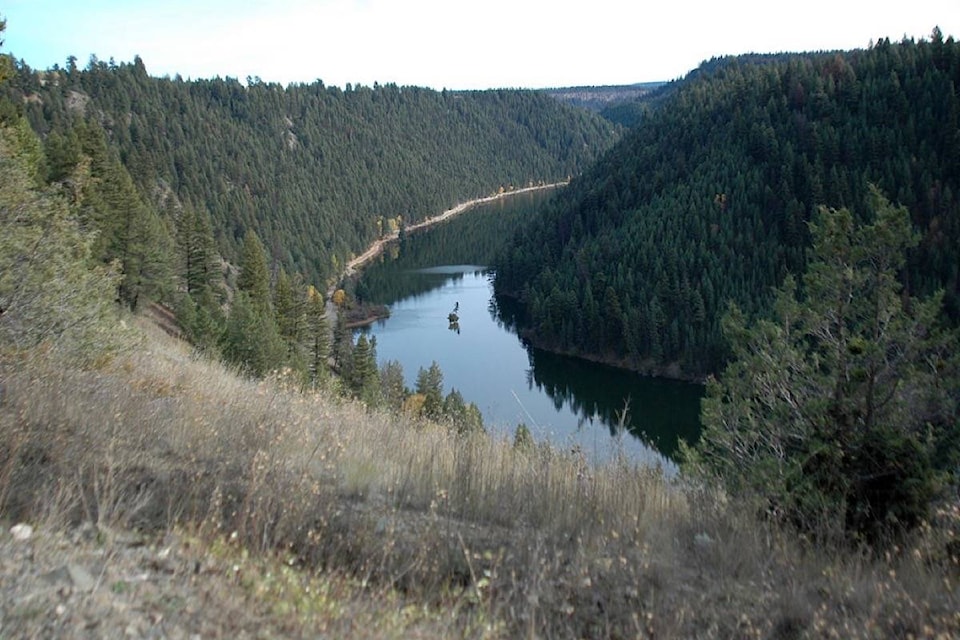When I spent three weeks, in the summer of 2015, editing the newspapers in Vanderhoof and Fort St. James while they awaited new editors, I learned very quickly not to say that I was “up north”. As someone who was born and raised in Richmond, has lived in Ashcroft for 22 years, and had never been north of Quesnel to that point, I certainly felt as if I was up north, but Vanderhoovians in particular were rather touchy on the subject. They weren’t “up north”, they were quick to inform me; they were, in fact, at the centre of the province, geographically speaking.
That might well be true, but a spot much further south in B.C. has an even grander claim: the Centre of the Universe. The spot in question is in the Deadman Valley, along what was once the Hudson Bay Company Fur Brigade route. Before we get to why it is known as the Centre of the Universe, however, a little history about the area (because here at Golden Country, it’s all about the history).
As a traveller heads west from Savona on Highway 1, the road dips down to cross a small river which emerges from sheer cliffs to meander through a pleasant-looking bit of grassland. It’s an idyllic spot, so the name of the river stands in stark contrast to it: the Deadman River. It is also known as Deadman’s River, Deadman Creek, and Deadman’s Creek; so while there is some disagreement over whether it’s a river or a creek, there seems to be no disputing that there was a dead man involved with it. But who was he?
He was a North West Company employee named Pierre Chivrette (or Charette; the surname varies according to the source). In 1817 he and a companion were travelling through the area and got into an argument about the best site to make camp, with the result that Charette (or Chivrette) was killed by his companion by the river (or creek) that now commemorates him.
It took some time, though, before Deadman was settled on. In 1827 it was mapped as the Chivrette River, and subsequent names included Knife River (presumably after the murder weapon), Dead River, Rivière de Défunt (from the French word for “late”, as in dead), and Defeant River (presumably a misspelling of Défunt). Next time you drive over the creek (or river), spare a thought for the sad fate of the man who inspired its (eventual) name.
Just past the bridge a road to the right leads through the Deadman Valley to Vidette Lake. “Vidette” comes to us courtesy of the French-Canadians such as Chivrette/Charette who worked for the fur-trading companies active in the area. The French word vidette means an outpost or mounted sentry, and the French-speaking fur company men used it to indicate the man who guarded the horses when they made camp. A lake would be a logical place for such a camp to be established, so Vidette Lake was probably an important stopping place on the Fur Brigade Trail.
Sometime later (probably around 1898), or so the story goes, a First Nations man found ore-bearing rock at Vidette Lake, about 50km from the present Trans-Canada Highway. He sold the information, and a sample, to the postmaster at nearby Savona for $10. The postmaster, for whatever reason, did not follow up on the find, and instead made a 50 per cent profit on his investment by selling the information to someone else for $15.
His failure to investigate cost him dearly. When the area was finally surveyed in 1931, a rich deposit of gold was found at Vidette Lake. A road into the valley was constructed, and shares of Vidette Mines Ltd. went on sale in 1933. Equipment and supplies were shipped to the area, and by 1934 a townsite had sprung up to accommodate 125 miners and their families.
More mines were set up nearby, and while they seem to have been abandoned fairly soon, the Vidette Mine was in full production for six years, during which time eight kilometres of tunnels, and 17 kilometres of road, were built, and some 28,000 pounces of gold were shipped out, at a value of $1 million in contemporary terms (more than $17 million in today’s money; at current gold prices, the value of the gold mined at Vidette Lake leaps to more than $35 million in 2018 dollars).
Ore supplies began to dwindle in 1938, and with the start of World War II a year later the mine closed and the village was gradually abandoned. A few remnants of the mine and village can still be seen, but be aware that the Vidette Lake Gold Mine Resort is privately owned and the land is accessible to paid clientele only.
Where, you might ask, does the Centre of the Universe come into it? Tibetan monks believe that the Centre of the Universe is located on Earth, and that its precise location can be determined using a series of tests.
In 1980 the Rinpoche, or Master Teacher, in San Francisco claimed that Vidette Lake was the spot where the Centre of the Universe was located. In November 1980 an apprentice monk was dispatched to the site. He performed a series of tests, and determined that the site could well be the Centre of the Universe. In 1984 the Rinpoche and others went to the site, and after more tests it was verified that the spot—on a grassy knoll overlooking Vidette Lake—was indeed the Centre of the Universe.
Since then, monks—and others seeking enlightenment—have visited the spot, which is said to emit energy (possibly as a result of the mineral content of the area). Unbeknownst to the monks, the same site had been a special place for local First Nations long before it was identified as the Centre of the Universe. Private tours can be arranged through the Vidette Lake Gold Mine Resort.
editorial@accjournal.ca
Like us on Facebook and follow us on Twitter
